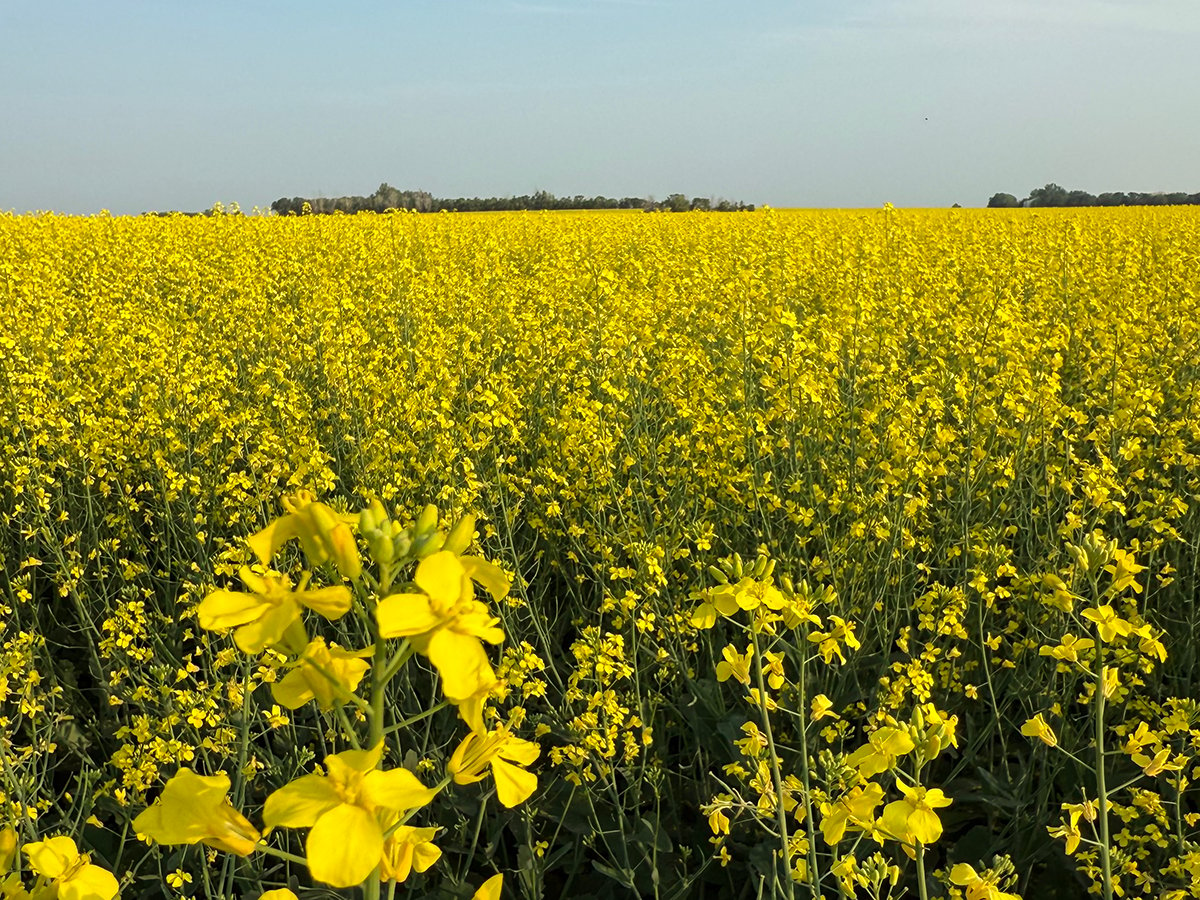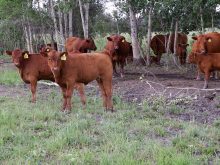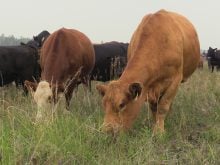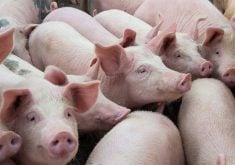ROSSBURN, Man. – As he walks into his pasture, Ray Armbruster points to what looks like a large, white rock lying between a small herd of cattle.
After a few more steps, the white object moves and Alpo the dog slowly rolls over, stretches and saunters toward his owner.
After a quick sniff of a visitor, Alpo does what most friendly dogs like to do. He rolls over on his back, hoping to get a belly rub.
Alpo, a three-year-old 70 kilogram Great Pyrenees, lives and sleeps among Armbruster’s herd of Angus and Shorthorn cattle.
Read Also

Canola support gets mixed response
A series of canola industry support measures announced by the federal government are being met with mixed reviews.
Yet, his job is not to protect the cattle from predators. Alpo’s primary role is to repel elk and deer that get too close to Armbruster’s herd.
Alpo is one of 25 dogs in a Manitoba Agriculture pilot project aimed at reducing contact between livestock and wildlife near Riding Mountain National Park.
The transmission of tuberculosis from elk and deer to cattle has concerned producers in the region for at least the last two decades.
A TB infection swept through Armbruster’s farm in 1997, and his herd was destroyed.
So when Manitoba Agriculture employees came up with the idea of using dogs to keep elk and deer at bay, Armbruster took up the offer.
“We have some very helpful folks (within Manitoba Agriculture) … they really try to help producers,” said Armbruster, who farms two kilometres from the park.
He obtained Alpo and another Great Pyrenees 2½ years ago at the beginning of the pilot project.
“They’ve been traditionally used for predators,” he said.
“It was kind of a novel idea to try and use them for repelling elk and deer.”
The provincial government has been building barrier fences around cattle feed yards adjacent to Riding Mountain for several years to limit contact between wildlife and cattle.
However, Morgan Moore, a livestock specialist with Manitoba Agriculture in Swan River, said the program is costly.
“That (program) still continues … but we were spending upwards of $15,000 per farm on these barrier fences.”
He said the department’s TB risk management program has a limited budget.
As a result, Moore said provincial employees began looking for another way to separate cattle and wildlife.
Borrowed idea
The idea to use guardian dogs to control the spread of TB originated from an experiment several years ago on a farm near Duck Mountain, Moore added.
A cattle producer had nearly 100 elk feeding with his 300 cattle and he had lost several calves to timber wolves.
“He (also) had countless white-tailed deer with the beef cattle. It was kind of the worst of everything. If it wasn’t the predator side, he was (also) losing feed.”
The province bought three Great Pyrenees dogs for the producer as a way to drive off predators and the elk.
“That following winter there wasn’t one elk on his property,” Moore said.
“He saw one white-tailed deer the entire winter and he never lost a calf.”
Given that success, Moore and others came up with the idea of using the dogs to control the spread of TB near Riding Mountain.
They bought two breeds of sheepdogs, Great Pyrenees and Maremma, and provincial employees delivered two-month-old Alpo to Armbruster’s farm.
“They dropped off a dog, a book and some food,” said Susan, Ray’s wife.
The instructions for training Alpo were basic – get him to bond with the cattle and the dog’s instincts would take care of the rest.
“We had an orphaned bottle-fed calf and we penned them together … for four to six weeks,” Armbruster said, noting the only time he saw Alpo was to deliver food and water.
“The puppy and the calf stayed there together.”
Alpo quickly learned his role. Susan took his food out one morning while he was still a pup, but Alpo didn’t have time to eat.
“He came to the dish (but) heard the coyotes. He left his dinner (to chase the predators),” she said.
Days off
Alpo now spends all his time with the herd, rarely coming to the farmyard. He works the night shift, driving off wildlife from dusk till dawn, which is why Alpo resembles a white rock during the daytime because those are his off hours.
He has a female patrol partner, Sassy, a 1½-year-old Great Pyrenees, but Sassy isn’t as dedicated to her job as Alpo. She spends her days napping by the Armbruster’s home and then goes on watch duty at night.
Sassy is a replacement for another female that initially worked with Alpo. That dog dislocated its hip and was euthanized.
The Armbrusters are pleased with Alpo and Sassy’s performance, but they said the dogs have limitations.
“I would still recommend to everybody that has a situation where they have interaction issues, if they can get a dog bonded successfully it’s going to make a huge difference,” Armbruster said.
However, the dogs are not used on the farm’s outlying pastures in the summertime. The territory is simply too big and it would require more dogs. So Alpo and Sassy patrol the feed yard in the winter and the pasture that surrounds the farm in the summer.
“It’s a great asset for our winter feeding areas, but it doesn’t really provide us the same solution for the summer,” Armbruster said.
Overall, the 16 producers in the pilot project are satisfied with the results, Moore said, but there has been a downside.
Of the 32 dogs placed on farms, several have died because of encounters with wolves and other predators, which is why Armbruster will wake up in the middle of the night when he hears howls and barking.
“I’m always a little bit worried because Alpo is so duty bound to those cattle. I know that if the (cattle) were threatened by a larger predator like wolves, he would stand in there and he would probably lose the battle.”
As a result, Armbruster will get up and assist his loyal watchdog when he hears something unusual.
“If I feel he needs support, I will intervene. I’m on his team.”
Manitoba TB guardian dog program
- Since the program started three years ago, 32 dogs have been placed at 16 farms. Seven dogs were lost due to fights with predators or because they didn’t bond properly to cattle on the farm.
- Great Pyrenees and Maremmas are used in the program. They are flock guarding dogs, known for their loyalty, a mellow demeanor and a thick white coat. The Maremma is a slightly smaller breed, typically weighing 30 to 45 kilograms, while Great Pyrenees usually weigh more than 50 kg.
- Male and females work in pairs. Morgan Moore, a livestock extension representative with Manitoba Agriculture, said males and females have distinctive roles on the team.
“The male is the social and outgoing dog …. They’ll raise their hackles and they’ll bark and wag their tale … to hold the attention (of an intruder or predator).”
Meanwhile, the female will slink out of sight and then attack, if needed, from the blind side or downwind.
- Bonding to cattle is crucial.
“The most important thing is to stay out of the road of the dog and let instinct take over,” Moore said.
Humans have to stay away when the dog is a puppy and allow it to bond solely with the livestock. After that, the sheepdog’s instincts take over.
- Certain dogs in the program have GPS collars.
After reviewing the GPS data, Manitoba Agriculture staff found that the dogs maintain a consistent patrol schedule.
“You can set your watch by a dog based on their routine. A dog will make the exact same trip through an area of bush or the perimeter of a field every night. It will be between 2 and 2:05 every night,” Moore said.
“We had no idea that they were that rigid.”
As well, GPS data shows the dogs patrol an area of about a quarter section, which is slightly less than the literature on the subject and indicates that dogs will patrol a radius of a 1.6 kilometres.















